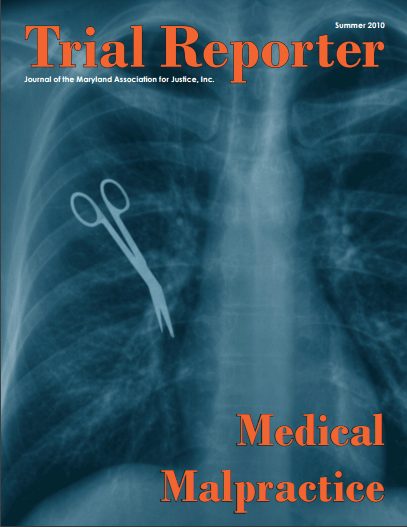
The Medicare Secondary Payer Statute: What’s All the Fuss About?
Introduction
As many of us who handle medical malpractice and personal injury litigation know, there is an 800-pound gorilla that figuratively sits beside us at every mediation, settlement discussion, and trial. That unsightly, overwhelming, impossible to ignore beast is Medicare. Those of us representing injured persons are aware of, and have been coping with, the reality of Medicare liens and their impact on our litigation practice for years. Given recent legislative changes, defense counsel and insurers are beginning to realize that which we are already knew: Yes Virginia, there is a Medicare lien and it comes with a reporting requirement.
Background of the Medicare Secondary Payer Statute
The Medicare Secondary Payer Statute (MSPS) exists as a recovery mechanism to ensure that Medicare recovers payment for bills when another party is responsible. 42 U.S.C. §1395y. Historically, it has been the plaintiff’s counsel’s obligation to report settlements to Medicare, and insure the payment of these lien obligations.
Prior to 1980 this statute only applied to Worker’s Compensation claims. In 1980, Congress added liability claims to this statute. Compliance with this statute from 1980 through 2003 was looser, entailing the completion of a Scantron form that provided various pieces of logistical information. This voluntary compliance was not as effective as the government had hoped, so in December 2003 the Medicare Prescription Drug, Improvement and Modernization Act was adopted. (Medicare Modernization Act, Pub. L. No. 108-173, 117 Stat. 2066 (2003) (codified as amended in scattered sections of 42 U.S.C. §1395)). The statute essentially provided that no matter how a settlement agreement or release was drafted, the plaintiff could not avoid reimbursing Medicare for the relevant lien. This Act made it clear that plaintiffs’ attorneys had an affirmative duty to verify and resolve any conditional Medicare payments made from the date of injury through the date of settlement.
From 2006-2007 Medicare centralized its recovery efforts through the Medicare Secondary Payer Recovery Contractor (MSPRC). In addition to this organizational effort, Section 111 of the Medicare, Medicaid and SCHIP Extension Act of 2007 (MMSEA) created an obligation for insurers to report to Medicare every time they settle a case on or after July 1, 2009. After this date, when a settlement is reached, the Responsible Reporting Entity (RRE) (which is typically the defendant’s insurance company) must determine if the injured party is entitled to
Medicare benefits. Registered RREs are given access to the Centers for Medicare and Medicaid Services (“CMS”) online Query Access System to aid them in making this determination. If it is determined that the injured party is entitled to these benefits, then the defendant must satisfy the notice requirement by providing approximately 50 points of data to Medicare regarding the Beneficiary and the claim through the Coordination of Benefits website.
While defendants vocalize their upset over the additional paperwork, the truly big news among RREs is the Act’s provision for a $1,000 a day penalty should an insurance company fail to notify Medicare of a settlement, and a double damages plus interest penalty should the Medicare lien be entirely ignored. 42 U.S.C. §1395y (b)(2)(B)(iii) For years many of us have struggled through mediations and settlement discussions as defendant’s counsel and insurer have minimized or disregarded our concerns pertaining to looming Medicare liens. Now that they are on the hook monetarily, their analysis has changed. Plaintiffs’ attorneys are advised to assist defense counsel and insurers in accurately understanding and satisfying the reporting requirement.
As is always the case, our client’s settlements are heavily influenced by the mood and perceptions of the defendant’s insurer. In response to this new legislation, there are several myths which have begun to circulate among ill- informed individuals. Some of these myths stem from ignorance, while others seem to be somewhat self- serving in their propagation. The following article will provide you with the tools you need to begin to combat these myths which, if not dispelled, have the potential for adversely affecting our client’s settlements.
Myth #1: The $1,000 a Day Penalty May be Applied to Defendants for Infractions Beyond the Failure to Provide Notification to Medicare
While defense counsel and insurers may object to these new obligations, we should take a step back, breathe deeply, and realize that things have not changed so drastically. Medicare must be notified of a settlement if the recipient is entitled to benefits. Plaintiffs’ attorneys have been providing this notification for years. Each time we have had a claim where our client has received Medicare benefits we have endured the agonizing correspondence battle with Medicare, in the hopes of getting a letter with a number that will allow us to begin to determine the settlement value of a case. Now, defendants must share some of our burden, and join us in the notification process. This dreaded $1,000 a day penalty (per beneficiary) only applies to defendants if they fail to notify Medicare of a settlement. 42 U.S.C. §1395y (b)(8)(E)(i) Any construction or interpretation that this penalty can be exacted on a defendant for anything other than its failure to notify Medicare is simply false.
While you are urged not to fall victim to scare tactics, or irrational demands, employed under the guise of the avoidance of $1,000 a day penalty, this is not to say that we should not provide the basic information defendants need to meet this requirement. Legitimate requests to which plaintiffs’ counsel should reply include:
injured party data (name, date of birth, social security number, Medicare ID number), primary plan data, policy holder data, plaintiffs’ attorneys’ contact information, incident data (date of incident, nature, cause, location), and resolution data (amount of settlement, date of settlement.) However, any demands made by defendants relating to the terms of the settlement, the settlement method of payment, or the time for the issuing the settlement payment, are separate issues and cannot be related to this penalty. For example, the new trend among Defendants is to demand at settlement that two separate checks be issued: one made out directly to Medicare for the exact lien amount, and the other made out to the Plaintiff for the remainder. The issuing of a separate check to Medicare is not a requirement under the reporting statute. Furthermore, the $1,000 a day fine which could be levied on a Defendant can only be exacted due to its failure to report the settlement, not for the Plaintiffs failure to satisfy the lien. This fine has no connection to the method by which the lien settlement payment is rendered, or the timing of the lien settlement payment. In short, the $1,000 a day fine has a very narrow application which cannot be stretched by the whim of a Defendant who wishes to hold on to settlement monies for as long as possible.
On a brief side note, given that the defendant will notify Medicare of the above referenced information once a settlement is reached, it might behoove plaintiffs to incorporate terms of the incident data as part of the settlement discussions. If a settlement is being reached because a portion of the injury originally claimed in the suit is now being excluded, plaintiffs should request at the time of settlement that the defendant’s notification reflect said excluded dates of service. The closer the defendant’s account matches that of the plaintiff; the easier it will be to resolve the lien.
Myth #2: Fines for double damages, plus interest, if Medicare’s reimbursement claim is ignored, are penalties which are easily and likely implemented against Defendants
This myth, in particular, is getting a lot of mileage, particularly when it comes time to issue the settlement check. It is true, 42 U.S.C. §1395y provides for the penalty of double damages for any entity that fails to properly reimburse Medicare. In order to recover payment made under this title for an item or service, the United States may bring an action against any or all entities that are or were required or responsible (directly, as an insurer or self-insurer, as a third-party administrator, as an employer that sponsors or contributes to a group health plan, or large group health plan, or otherwise) to make payment with respect to the same item or service (or any portion thereof) under a primary plan.
The United States may, in accordance with paragraph (3)(A) collect double damages against any such entity. 42 U.S.C. §1395y(b)(2)(B)(iii) The threat of paying money for failure to satisfy a Medicare lien is not really new to plaintiff attorneys, as we have been liable for payments for our clients’ Medicare liens for years. We know not to disburse funds prior to negotiating the lien, issuing the payment, and finally receiving acknowledgment by Medicare of the satisfaction of said lien. Once again, while we have lived with this reality, defendants are beside themselves now that they face any kind of liability in this complex process which we have been navigating for so long.
The reality is that the practical nature of the process for satisfying a Medicare lien makes the implementation of double damages plus interest extremely unlikely. There are a multitude of lengthy steps which must be taken in between the settlement, the failure to pay, and the levying of the penalty before this sanction can even be sought. First, 60 days from the date of the correspondence on Medicare’s final demand letter must lapse. Then there is a 180-day period during which the MSPC permits payment to be rendered in full. After the passing of these first 240 days, an “intent to refer” letter (to the Treasury for collections) will be sent by the MSPC to the beneficiary. This letter permits 60 days for the recipient to produce a response. When the Treasury receives this collection from Medicare, it then sends a letter to the beneficiary requesting the satisfaction of the debt. If unsuccessful, it then seeks a remedy though the Tax Refund Offset Program, whereby the Treasury seeks payment by offsetting government benefits and/or refunds. Counsel for the defendant or the plaintiff, or the defendant himself, is not usually a target until this final step is fully explored. This is not to say that these penalties cannot be exacted, however, it is highly unlikely given that a conglomeration of neglectful acts by numerous irresponsible parties must first take place.
As mentioned in the preceding section, the new party line by defense counsel and insurers (that many of us have heard in our recent settlement discussions) is that they have to hold on to all funds until they receive a conditional payment letter from Medicare. They then offer to either wait on disbursement until plaintiff’s counsel has negotiated the lien, or they offer to cut two checks, one to Medicare for the full amount of the lien and one to the plaintiff for the remainder. Should the plaintiff choose the latter, they can then seek reimbursement for overpayment of the lien from Medicare after the lien is further negotiated. For some reason, despite the fact that we have always faced this liability, this knowledge in it of itself is insufficient for defendants. Defendants continue to insist on holding on to their funds (all the while accruing interest), in order to protect themselves from this unlikely penalty.
There is no compelling reason for a defendant to withhold settlement proceeds from a plaintiff. If the defendant is truly “afraid” of this unlikely penalty, then the implementation of the following language in the settlement release should alleviate these anxieties:
Plaintiff understands that the Medicare Secondary Payer Act (42 U.S.C. §1395y(b)) (the “Act’) applies to any personal injury settlement involving a Medicare beneficiary. As part of the Act, Plaintiff has an obligation to verify entitlement and resolve conditional payment, and [Defendant] has an obligation to report. Accordingly, a tort recovery record may need to be established by Plaintiff and a reporting event may be triggered, which would be the responsibility of the [Defendant], by and through its insurance carrier. In the case of a reportable event, [Defendant] will comply with the Act and all applicable reporting guidance provided by the Centers for Medicare and Medicaid Services (CMS). [Defendant] will determine whether the claim is reportable under the Act. If there is an obligation to establish a record with CMS, Plaintiff shall provide [Defendant] information validating that a tort recovery record has been established with CMS, and/or its recovery contractor. The parties expressly agree that payment of settlement proceeds is not conditioned upon Plaintiff providing proof that all Medicare reimbursement claims and obligations have been satisfied. Rather, [Defendant] agrees to forward the settlement proceeds within the time frame agreed between the parties at the time of settlement once an executed release has been tendered by Plaintiff. Following Plaintiff’s opening of a tort recovery record, Plaintiff’s attorney agrees to: (1) hold all settlement proceeds in a client trust account (or similar account should needs-based government benefits require preserving) until Plaintiff obtains claims satisfaction documents from CMS and/or its recovery contractor; and (2) provide [Defendant] with written proof of the satisfaction of any claim asserted by Medicare pursuant to the Act prior to disbursing to Plaintiff any proceeds received in connection with this settlement. As part of this settlement, Plaintiff agrees to indemnify, defend, and hold [Defendant] harmless against and from any such Medicare reimbursement claims. (The author is grateful for this suggested release language provided by the Garretson Firm Resolution Group, www.garretsonfirm.com. )
This release language is a recommendation provided by a firm who specializes in aiding other law firms in the Medicare lien resolution process. While there is no statutory or case law support for this language, it has been used by them in multiple settlements and has provided multiple Defendants with the assurances needed to release funds to the Plaintiff in the face of these new issues.
Myth #3: This New Statute Requires Set-Asides for Liability
Settlements for the Purpose of Satisfying Medicare Liens
For those of you who are unfamiliar with the term “set aside,” it refers to funds from settlements or verdicts which must be set aside to cover future medical damages. The parsing of this money relieves Medicare of its responsibility for paying claim-related medical bills which are incurred after the settlement or verdict. Set asides have been a regular part of worker’s compensation claims for years. Despite what defendants might tout, at the present time there are no specific provisions, statutes, or memoranda from CMS requiring a Medicare set-aside in liability settlements.
Section 111 of the Medicare, Medicaid & SCHIP Act of 2007 (MMSEA) is at the center of this hotly contested debate. As previously discussed, this new statutory language strictly deals with reporting requirements. Section 111 simply completes the statutory loop which was begun on December 5, 1980, when Medicare’s conditional payment rights were acknowledged. This loop was continued in 2003 in Section 301 of the Medicare Modernization Act (referenced above) when enforcement provisions were placed on Medicare beneficiaries and plaintiff attorneys. Now this loop has been closed with Section 111 which institutes a reporting obligation on self -insured defendants and/or carriers. Nowhere, in any of this, does it state that anything has changed regarding set asides and liability claims.
Medicare has made several unofficial statements addressing the issue of set-asides in liability claims during town hall teleconferences. One such statement was that “the new statutory language changes nothing as it pertains to the status quo with set-asides of liability or worker’s compensation claims.” (Barbara Wright, CMS’ Acting Director of the Division of Medicare Debt Management, 2/25/2010, 12:00 p.m., Town Hall Teleconference www.cms.gov, NGHP transcripts) (Note: Complete copies of all town hall teleconference transcripts referenced in this article can be located at www.cms.gov)
On March 16, 2010, during another Town Hall Teleconference, Wright stated the following as it pertains to set asides in the context of liability claims:
As we’ve said on many calls, CMS has formalized processes to review proposals for workers’ compensation, Medicare set aside amounts. It does not have the same formalized process for liability Medicare set aside arrangements…. We have a process for an informal process on the liability side that if a plaintiff’s attorney or insurer, etcetera, wishes to approach the appropriate CMS regional office and the regional office has the ability to do so workload or otherwise, that they can choose to review a proposed set aside amount if they believe there is significant dollars at issue. (03/16/2010, 12:00 p.m., Town Hall Teleconference, www.cms.gov, NGHP Transcripts.)
On February 23, 2009, CMS released an alert which stated, “The new Section 111 requirements do not change or eliminate any existing obligations under the MSP statutory provisions or regulations.” (CMS Alert, 2/23/09, www.cms.gov, CMS Alerts). Medicare representatives have also stated (in one of several town hall teleconferences) that while Plaintiffs are encouraged to consider using set asides in liability settlements where there are substantial future damages in play, for which one may easily account, there is no language requiring such actions. (03/16/2010, 12:00 p.m., Town Hall Teleconference, www.cms.gov, NGHP Transcripts)
While the statements referenced above (made during town hall teleconferences) are not considered a legally binding authority, they can be viewed as subjective evidence that Medicare has not changed its’ stance on set-asides in liability claims. This sentiment seems to be reflected by the absence of new statutory language, and the absence of the issuing of formal memoranda by Medicare addressing a requirement for set-asides and liability claims. In 2001, Medicare formally acknowledged set-asides in worker’s compensation claims in the “Patel Memorandum.” After this, several other formal memoranda were issued by Medicare addressing set-asides in worker’s compensation claims. No such memoranda have been issued for set-asides in liability claims.
The conundrum that continues to plague many of us is that the statutory language for set asides in worker’s compensation claims is identical to the language pertaining to set asides in the context of liability claims:
In general, payment under this section may not be made, except as provided in subparagraph (B), with respect to any item or service to the extent that (i) payment has been made, or can reasonably be expected to be made, with respect to the item or service as required under paragraph (1), or (ii) payment has been made or can reasonably be expected to be made under a workmen’s compensation law or plan. 42 U.S.C. §1395y(b)(2)(A)(i) and (ii).
This duplicative language was acknowledged by Wright during a town hall meeting where the subject of set asides in liability claims was addressed. After touching on this linguistic similarity, she then acknowledged the practical difference between the two types of claims. Specifically, that Medicare has a formal system for reviewing set aside in worker’s compensation claims, while no such formal system exists for liability claims. (03/16/2010, 12:00 p.m., Town Hall Teleconference, www.cms.gov, NGHP Transcripts.) Once again, while not a legal authority, her statement does reference the obvious: presumably an entity cannot detect and evaluate claims when there is no system in place to do so.
The issue of set asides and liability claims remains somewhat muddled because Medicare representatives continue to speak out of both sides of their mouth. They have stated in town hall teleconferences that, on the one hand, they cannot guarantee that there will be no repercussions for Plaintiffs or Plaintiffs’ attorneys who fail to properly address a situation where a set-aside would “make sense” in a liability claim. On the other hand, they acknowledge that there is no formal system in place to detect such a situation. (03/16/2010, 12:00 p.m., Town Hall Teleconference, www.cms.gov, NGHP Transcripts.) There is the distinct feeling of “proceed at your own risk.” The odds of being caught in a situation where a set aside should have been created and was not in a liability settlement are slim, and perhaps even unlikely, given all of the above. But no one from Medicare will say it is impossible that a Plaintiff will find himself in such a scenario.
It seems the safest thing for Plaintiff attorneys to do is to proceed as we have in the past when it comes to set asides and liability claims. Medicare representatives continue to communicate through town hall teleconferences and alerts (www.cms.gov) that nothing has changed other than the new reporting requirements. Our own evaluation of the statute shows us that there is nothing new that has been instituted that would indicate a change in Medicare’s policy for set asides in liability claims. Our past practices regarding set-asides and liability claims in the face of the existing, unchanged, statutory language, should provide us with some comfort in proceeding as we have in the past.
An attorney who in the past has made the decision to be cautious and have a settlement provide for a set aside where future damages are substantial in cost, definitive in nature, and easily identifiable, should continue to do so. This would be the course of action to be taken if one decided to heed the recommendation (but still not a requirement) as set forth by Wright during the March 16, 2010 CMS town hall teleconference. However, barring the scenario of substantial, definitive, easily identifiable, future damages, there is no statutory reason to even engage in a debate regarding set asides and liability claims. Surely if such a drastic change was made, it would be found in the statute, or mentioned by CMS in a formal oral or written format. Therefore, while the set-aside requirements for worker’s compensation claims remain, there is still no set-aside requirement for liability claims and the new notice requirement for defendants does nothing to change this.
Conclusion
These new reporting rules change little insofar as they reiterate the good practices in which plaintiff’s counsel have engaged. We have always represented Medicare beneficiaries, and we have been reporting claims and negotiating liens for years. The fact that defendants are upset that they have to fill out paperwork and now share the same liability we have held for years, will in no way deter us from advocating on behalf of victims in need of representation.
One attorney asserted in a recent article that these rules may have a chilling effect on the willingness of the plaintiffs’ bar to represent Medicare recipients. That we will no longer take cases with high Medicare liens because the lien could wipe out the recovery. First, we know that Medicare would prefer to recover something, rather than nothing. In cases where the lien is high, we do our best to negotiate a reasonable settlement with Medicare to ensure that it receives compensation, without the denial of recovery for our clients. Second, if defendants and their attorneys are so concerned about our clients and their right to representation, then perhaps they should start considering making good faith offers of settlement that can accommodate large Medicare liens, as well as compensation for our clients.
Cooperation and communication are keys in any settlement process. We should provide the defendant with the information it needs to satisfy this new reporting requirement and we should do so early in the settlement negotiation process. However, we should not allow this new legislation to be twisted into a mechanism by which defendants can make unreasonable demands for the issuing, structuring, or rendering of settlement payments. After all, it is just a notice requirement.



